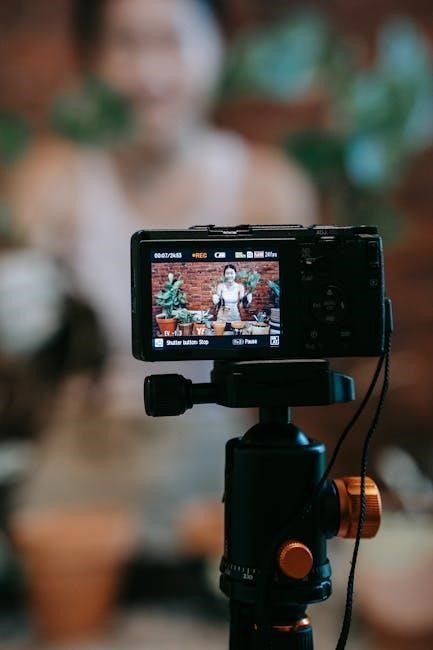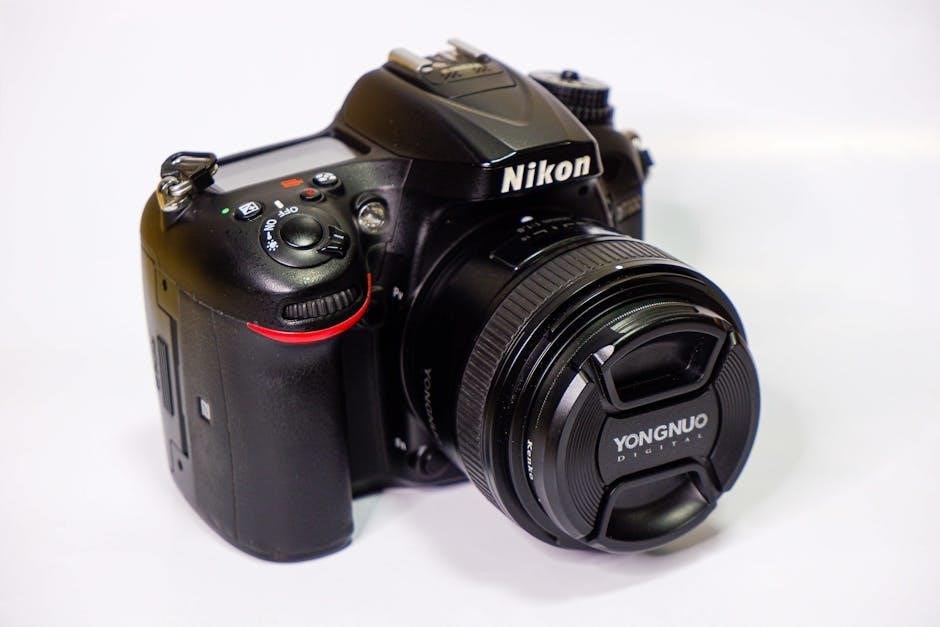Cop cameras, or body-worn cameras, are devices used by law enforcement to record interactions, ensuring transparency and accountability. They capture HD video, audio, and provide night vision functionality, aiding in evidence collection and public trust. These tools are essential for modern policing, promoting safety and accountability for both officers and the public.
1.1 Purpose and Benefits of Body-Worn Cameras
Body-worn cameras are designed to enhance transparency and accountability in law enforcement. Their primary purpose is to record interactions between officers and the public, providing an objective record of events. These devices help ensure accuracy in evidence collection, promoting fairness in legal proceedings. Additionally, they foster public trust by documenting police conduct and promoting accountability. The cameras also serve as a deterrent against misconduct, encouraging both officers and citizens to behave appropriately. Furthermore, they aid in training officers by allowing review of real-world scenarios. Overall, body-worn cameras are a vital tool for modern policing, balancing safety, accountability, and community relations effectively.
1.2 Overview of Key Features and Functionality
Cop cameras are equipped with advanced features to ensure high-quality evidence collection. They offer HD video and audio recording, night vision capabilities for low-light environments, and infrared sensors for enhanced clarity. Many models include loop recording, which continuously captures footage and overwrites old files when storage is full. Data management systems allow secure storage and easy access to recordings. Privacy settings enable officers to pause or stop recording sensitive situations. Durability is a key feature, with cameras designed to withstand rough conditions. Connectivity options like USB enable seamless data transfer to computers for review and analysis. These features collectively enhance the effectiveness of body-worn cameras in law enforcement operations.

Installation and Setup Instructions
Installing cop cameras involves mounting the device, connecting via USB, and setting up software with drivers. Ensure proper positioning for clear recording and functionality.

2.1 Hardware Installation Steps
To install the cop camera hardware, begin by unpacking the device and mounting it on the officer’s uniform or vehicle. Connect the camera to the power source and ensure it is securely fastened. Use the USB cable to link the camera to a computer for driver installation, following the on-screen instructions. Position the camera to capture clear footage, avoiding obstructions. Finally, test the camera to ensure proper recording functionality and adjust as needed for optimal performance.
2.2 Software Setup and Driver Installation
Connect the cop camera to your computer using the provided USB cable. Double-click the auto driver installation file, typically labeled “Body” or found on the CD. Select your preferred language and follow the on-screen instructions to install the necessary drivers and software. Once installed, the camera management software will guide you through configuration options. Ensure all settings are properly configured for optimal performance. This process is essential for enabling the camera’s recording and data management features. After completion, test the camera to confirm successful setup and functionality.
2.3 Mounting and Positioning the Camera
Mount the cop camera securely on your uniform or equipment using the provided clips or brackets. Position it on your chest or shoulder for optimal field of view. Adjust the camera angle to ensure it captures interactions clearly without obstruction. Tighten the mounting hardware to prevent movement during activity. Test the placement by moving to confirm the camera remains stable and the view is unobstructed; Proper positioning ensures accurate evidence collection and adherence to agency policies. Always refer to the manufacturer’s guidelines for specific mounting recommendations to maintain functionality and reliability.
Legal and Policy Compliance
Adhere to the Law Enforcement Officer-Worn Body Camera Act and agency policies. Ensure privacy protections, data security, and compliance with local regulations to maintain public trust and legal standards.
3.1 Understanding the Law Enforcement Officer-Worn Body Camera Act
The Law Enforcement Officer-Worn Body Camera Act mandates that agencies using body cameras adopt written policies, ensuring accountability and transparency. These policies must address recording practices, data storage, and privacy protections. Officers are required to activate cameras during interactions, with exceptions for sensitive situations. The Act also emphasizes public access to recordings, balancing transparency with privacy rights. Agencies must train officers on policy compliance and maintain secure data storage systems. This framework aims to build public trust while safeguarding individual rights, ensuring responsible use of body cameras in law enforcement operations.
3.2 Agency Policies for Body Camera Usage
Agency policies for body camera usage must be comprehensive, ensuring ethical and legal compliance. Officers are typically required to activate cameras during interactions, such as traffic stops or arrests. Policies often outline specific scenarios where recording is mandatory or prohibited. Training is essential to ensure officers understand and follow protocols. Agencies must also address data management, including storage, retention, and access procedures. Privacy considerations are critical, balancing transparency with individual rights. Policies may include guidelines for public access to recordings, ensuring accountability while safeguarding sensitive information. Regular audits and updates to policies help maintain compliance with evolving laws and technological advancements in body camera usage.
3.3 Privacy Considerations and Data Protection
Privacy considerations are paramount when deploying body cameras, requiring a balance between transparency and individual rights; Agencies must implement strict data protection measures, such as encryption and access controls, to safeguard recorded content. Policies often restrict recording in sensitive areas like hospitals or homes without consent. Data retention periods are typically defined to prevent indefinite storage of non-evidentiary footage. Officers are trained to avoid capturing unnecessary or invasive material. Compliance with local and federal regulations ensures that privacy laws are upheld. Public trust is maintained by transparently communicating how data is managed and accessed, fostering accountability while respecting personal privacy rights.
Operational Features and Settings
Cop cameras feature various recording modes, night vision capabilities, and looping functionality to ensure continuous capture. Settings allow customization of video quality, audio recording, and data management.
4.1 Recording Modes and Looping Functionality
Cop cameras offer multiple recording modes, including event, continuous, and manual recording. The looping functionality allows the camera to continuously record, overwriting older footage unless an event is flagged. This ensures storage efficiency while capturing critical moments. Pre-buffer recording enables the camera to retroactively save footage before an event is triggered. Users can customize settings to prioritize video quality, resolution, and audio capture. These features ensure seamless evidence collection, with options to lock important recordings to prevent accidental deletion. The camera’s operational modes are designed to adapt to varying situations, providing reliable performance in high-stakes environments while maintaining data integrity and user control.
4.2 Night Vision and Low-Light Recording Capabilities
Cop cameras are equipped with advanced night vision and low-light recording features, ensuring clear video capture in dimly lit environments. Infrared LEDs provide illumination in darkness, enabling the camera to record high-quality footage without external light sources. The light sensor automatically adjusts settings to optimize video clarity in varying conditions. This functionality is crucial for law enforcement, as it ensures evidence can be collected even in low-visibility situations. The camera’s ability to adapt to light changes minimizes blur and enhances detail, making it an indispensable tool for nighttime operations and indoor investigations, where visibility is often limited.
4.3 Data Management and Storage Solutions
Effective data management and storage are critical for cop cameras, ensuring secure and organized video evidence. Built-in storage solutions, such as internal memory or removable SD cards, allow for ample recording capacity. Additionally, cloud-based platforms provide scalable storage options, enabling agencies to access and manage data remotely. Encryption and secure access protocols protect sensitive information from unauthorized breaches. Automated upload features streamline the process, transferring footage directly to designated servers. Regular backups and redundant storage systems ensure data integrity, preventing loss of crucial evidence. These solutions help law enforcement maintain compliance with retention policies and efficiently manage large volumes of digital evidence.

Maintenance and Troubleshooting

Regularly clean the camera lens and check for firmware updates to ensure optimal performance. Address common issues like connectivity problems or corrupted files promptly to maintain functionality.
5.1 Care and Cleaning of the Camera
Regular cleaning and maintenance are crucial for optimal functionality. Use a soft, dry cloth to wipe the lens and exterior to prevent smudges and scratches. Avoid harsh chemicals or abrasive materials that could damage the device. Store the camera in a cool, dry place to prevent overheating. Check for firmware updates periodically to ensure all features work correctly. If the camera emits smoke, unusual noises, or smells, disconnect power immediately. Proper care extends the device’s lifespan and ensures reliable performance during critical situations. Always follow the manufacturer’s guidelines for cleaning and handling to maintain the camera’s integrity and functionality.
5.2 Updating Firmware and Software
Regular firmware and software updates are essential to ensure optimal performance and security. Connect the camera to a computer using the provided USB cable and launch the management software. Navigate to the update section, select the latest firmware version, and follow the on-screen instructions. Do not disconnect the camera during the update process. Once complete, restart the device to apply changes. Updates often include improved features, bug fixes, and security enhancements. Always verify the update was successful by checking the version number. Keeping the firmware and software up-to-date ensures the camera functions reliably and maintains data integrity for law enforcement operations.
5.3 Resolving Common Technical Issues
Common issues with cop cameras include poor video quality, connectivity problems, or firmware glitches. To resolve these, restart the camera or reconnect it to the USB port. For video issues, ensure proper lighting and check if night vision is enabled. If the camera fails to record, verify storage capacity and formatting. Use the provided management software to diagnose and repair firmware issues. Contact technical support if problems persist. Regularly cleaning the lens and updating software can prevent malfunctions. Always refer to the user manual for specific troubleshooting steps tailored to your device model and software version for effective resolution.
